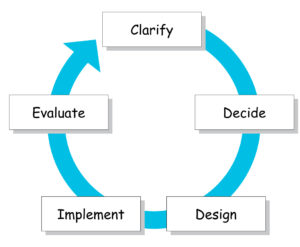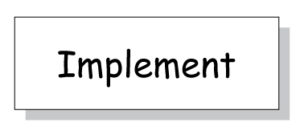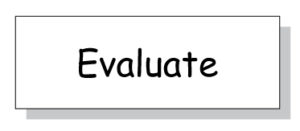Basil Schader
1. Introduction; the significance of planning
Teaching is a complex act in which a number of plannable aspects interact with a number of unpredictable or barely plannable factors. The plannable aspects include the following: clarification of requirements, goal setting, selection of contents, determination of teaching methods, lesson design, considering how learning success can be ensured and assessed.
The unplannable or barely plannable aspects include, among others, the disposition of the students as a whole or individually (which may be influenced by a conflict during break, or family problems, for example), the disposition of the instructor, the weather (e. g. excessive heat that inhibits learning), distraction by a forthcoming event (school camps, vacations, tests), group dynamic processes, etc. Since these factors are always at play here, even optimal planning is not a one-hundred-percent guarantee for a successful class.
HLT instructors who teach not just one, but mostly different classes and levels at the same time, know better than anyone else that nothing ever gets done without proper planning. Without careful consideration of which group does what, when and why, chaos would reign, and the motivation of the students would understandably soon be zero.
This would be fatal, as HLT instruction is optional in most places and can only survive if it attains the highest possible quality and attractiveness – which again is impossible without professional planning.
In the following pages, we are going to focus first on different predictable factors and elements, based on a current planning instrument, developed by experts of the Zurich University of Teacher Education, which we adapt for the specific situation of HLT. Subsequently, the different temporal dimensions of planning will be discussed – from yearly planning to planning of individual sequences. Important for the specific implementation for both are the articles and examples in part B, which stem from the teaching practice of HLT instructors.
2. The steps and elements of planning at a glance
The following remarks refer to rough and detailed planning of double lessons, as HLT instruction occurs mostly in this context (one double lesson per week). Obviously, these considerations apply for single lessons and bigger blocks as well. For yearly, quarterly, and thematic planning, see below.
Lesson planning at a glance can be understood as a loop, which leads from one double lesson to the next and from one week to the next. The individual steps (divided into three phases: preliminary considerations- implementation- evaluation) are explained in detail below.


Clarifying of the ‹overall composition›, the theme(s), requirements, etc. This concerns preliminary considerations and rough planning; first notes are taken.
- ‹Overall composition›: do I plan a double lesson for a common topic for all levels (e. g. “friendship”), with differentiated tasks according to level of proficiency, or do I plan a double lesson with 2–3 level-specific topics (e. g. 1st & 2nd grade: introduction of new letters; 3rd grade: reading practice; 4–6th grade: work on the theme of ‹writing texts›; 7–9th grade: preparation of presentations), or do I plan a hybrid form (e. g. a collective 20 minute conversation on the topic ‹friendships›, followed by 40 minutes of level-specific activities on language themes, then watch and discuss a film together for 30 minutes)?
- Selection of the topics /specific themes or tasks for individual group levels (for topic examples, see above).
- Pedagogical relevance, substantive main points, consideration of the theme’s relevance to everyday life of the students.
- Requirements of the students: What prerequisites and prior knowledge do the students have in terms of the themes of the double lesson? In light of the bicultural-bilingual knowledge and competences they may have acquired, how can I optimally connect with their living environment and reality? What may need further review from the previous week’s material, how can I segue from that to the new topic?

Decide which goals and contents to choose for the individual groups, which teaching and social forms are appropriate, and how to assess learning success. This step is about converting the preliminary considerations into concrete terms. It involves more specific notes and perhaps first entries on the planning form.
Questions to be answered in this step:
- Goals/contents: which goals do I set for the individual group levels; which content do I select for them? (I can either proceed from the defined goals and look for appropriate content or proceed from a chosen content and define appropriate goals for it). Example: the students develop their writing competence in the mother tongue [= goal] in that they compose simple descriptions of objects (following instructions) [= content] or: the students read aloud and record short poems [= content], to practice their oral expression [= goal].
- Teaching methods and social forms: Which instructional methods (discussion, presentation, in-class work, completing worksheets, etc.) and which social forms (individual-, partner-, or group work, etc.) correspond to the goals and content which I have selected for the individual groups? Is the choice of teaching methods and social forms realistic in view of my multi-class teaching, do I have tasks planned for each group level which can be accomplished without my help, so that I am available for the other groups?
- Assessment of learning success: How can I evaluate if my goals have indeed been attained, if the students have actually learned and understood what I have led them to learn? Possibilities: final conversation (better: concluding review of students‘ notes) to the question “specifically, what have I learned today?”; instructors‘ observation/notes about individual students‘ learning; assignment to students who (working with a partner) need to explain to each other the facts of the assignment; written test as learning assessment (which should, however, be only one of many forms!).

Designing the lesson(s) in a concrete planning scheme, which shows the time flow, the activities of the instructor and the various student groups and which serves as a “script” during the lesson(s). This step involves the implementation of considerations from the previous two steps into concrete, detailed planning, and to record it on a planning form in chronological sequence, respectively.
- The distribution of the activities by instructor and students must carry special weight for multiclass instruction, which is characteristic for HLT. Each group level should have the instructor at least once “for themselves”, whereby the younger students generally require more attention than the older ones. It is of course highly possible (and quite appropriate!) that older students explain something to the younger ones, or that the students work in tandem or small groups; this also lessens the burden on the instructor.
- The planning form should be functional and clearly arranged. It should always contain a timeline or a rubric, respectively, with a time display. If one has to parallel-teach three group levels, three columns (one each per group or level) should be inserted, where the activities of the respective groups are recorded. Those with a colored border (or highlighted in grey) are those phases during which the teacher works with the group in question. These markings also show instantly where the teacher is at any given time. See also the example in chapter 11 B.6.
Example of a planning form
(compare also the example in 11 B.6)
| General data | |||
| Date | Class, Location | ||
| Theme of the (double)lesson | |||
| Theme Lower level/level I |
Theme Middle level/level II |
Theme Upper level/level III |
|
|
|
|||
| Goals of the (double)lesson | |||
| Goals Lower level/level I |
Goals Middle level/level II |
Goals Upper level/level III |
|
|
|
|||
| Media to be prepared | |||
| Homework assignments | |||
| Homework assignments Lower level/level I |
Homework assignments Middle level/level II |
Homework assignments Upper level/level III |
|
|
|
|||
| Specific lesson planning (Indicate in which sequences the instructor works with the corresponding group, compare with the example in chapter 11 B.6!) |
|||
| Time | Lower level/level I | Middle level/level II | Upper level/level III |
|
|
|||
|
|
|||
|
|
|||
If planning involves just one group level or class, the form can be further differentiated, as depicted in the following example:
| General data | ||||
| Date | Class, location | |||
| Theme of the double lesson | ||||
| Goals of the lesson | ||||
| Media to be prepared | ||||
| Homework assignments | ||||
| Specific lesson planning | ||||
| Time | Student activities | Info. about subgoals, social forms, etc. |
Instructor activities | Media |
|
|
||||
|
|
||||
|
|
||||
|
|
||||

It will become evident here, as already indicated in section 1, that not everything planned can be implemented and achieved without problems. This is not tragic, and it challenges the flexibility and creativity of the instructor..
However, the next step is all the more important:

The clarification of these issues first serves one’s own reflection and professionalization. Secondly, it is indispensable as a basis for continued work in the next lessons; that is, for the referenced point “clarifying the prerequisites”. This closes the planning loop, as depicted in the graphic at the beginning of the chapter.To what extent were the planned objectives achieved; why were some things not accomplished; what should perhaps be repeated or requires a deeper knowledge, what comes next, etc.?
3. Planning in various dimensions: from the annual plan to the individual sequence
In the reality of the school, detailed planning of (double) lessons as described above, actually ranks last in a long process. Generally, this process begins with a relatively rough year-long or semester planning which serves as a very useful orientation. This is then further refined and specified into quarter or monthly planning, or a theme planning, until a solid context and framework has been created, within which the individual lesson planning has its place and purpose.
The planning for the year and semesters are particularly important because of various reasons:
- They present an overview over a longer period of time and serve as frame of reference for planning in detail.
- They are an occasion to verify and ensure the compatibility of the anticipated contents with the curricula of the country of origin and the immigration country.
- They present also an opportunity for identifying themes in the selection process that offer a potential cooperation with regular classroom instruction. The appropriate arrangements with regular classroom instructors should preferably occur very early on.
Examples for a semester planning and a theme planning can be found in part B (11 B.4 and B.5), which illustrate different ways and systematic possibilities. The semester planning example in 11 B.4 is comprised of five columns for information like months, overarching themes (if available) and more specific information for three levels or competencies. (see below: example for semester planning.)
The theme planning example in 11 B.5 begins with a year-long or semester planning, with large thematic blocks in sequential order (similar to the monthly themes discussed above, but perhaps a little more flexibly). The system here follows the four great language processing areas speaking, reading comprehension, listening comprehension and writing with a column for each one. These could of course be expanded with other columns, such as “knowledge of civilization”, “intercultural contents”, “literary learning”. (see below: example of theme planning.)
The schema of 11 B.4 can of course also be applied for theme planning, just as vice versa the schema of 11 B.5 can serve as the basis for yearly planning.
It remains to be mentioned that the first and partially the second grades as well generally hold a special status, as the instruction here occurs in the first language which, depending on the language and the writing system, demands much more or less time. A special plan needs to be created for these classes.
Example: semester planning
| Month | Theme | Lower level/level I | Middle level/level II | Upper level/level III |
|
|
||||
|
|
||||
|
|
||||
|
|
Example: theme planning
| Theme, duration in weeks: | ||||
| Level | speaking | reading comprehension |
listening comprehension |
writing |
| Lower level I |
||||
| Middle level II |
||||
| Upper level III |
||||
Bibliography
Grunder, H.-U. among others. (2012): Unterricht verstehen – planen – gestalten – auswerten. 3rd ed. Baltmannsweiler: Schneider Verlag Hohengehren.
Meyer, Hilbert (2007): Leitfaden zur Unterrichtsvor-bereitung. Berlin: Cornelsen Scriptor.
Schneider, Jost; Schlechter, Dirk (2013): Unterricht einfach planen und vorbereiten: Das Praxisbuch. Donauwörth: Auer.
Zumsteg, Barbara among others (2014): Unterricht kompetent planen. Vom didaktischen Denken zum professionellen Handeln. 5th ed. Zürich: Verlag Pestalozzianum.
See also the framework curriculum, published by the Education Department of the Canton of Zurich, and translated into 20 languages. HSK (= HLT): Link: http://www.vsa.zh.ch/hsk
Thanks
Heartfelt thanks to Barbara Zumsteg, Zurich University of Teacher Education, for her critical review of the text.






